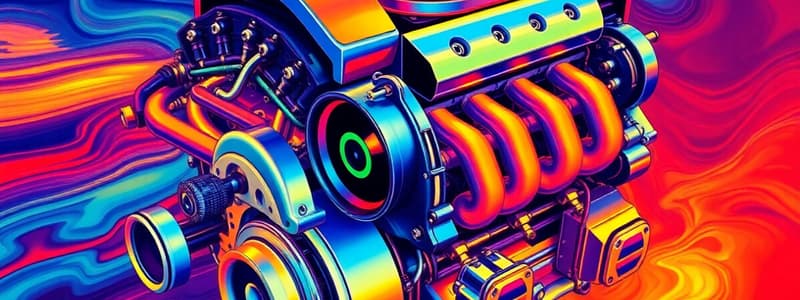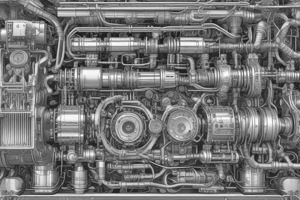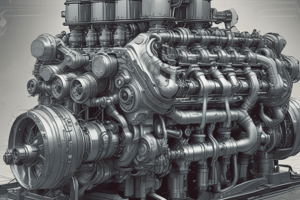Podcast
Questions and Answers
Supercharging increases the air density supplied to the engine, enhancing its power output.
Supercharging increases the air density supplied to the engine, enhancing its power output.
True (A)
The method of increasing the power output of an engine does not depend on the amount of air inducted per unit time.
The method of increasing the power output of an engine does not depend on the amount of air inducted per unit time.
False (B)
Increasing the engine speed always leads to improved power output without any drawbacks.
Increasing the engine speed always leads to improved power output without any drawbacks.
False (B)
Supercharging can help compensate for power loss due to altitude in aircraft engines.
Supercharging can help compensate for power loss due to altitude in aircraft engines.
The rate of increase of maximum cylinder pressure with an increase in compression ratio is greater than that achieved by supercharging.
The rate of increase of maximum cylinder pressure with an increase in compression ratio is greater than that achieved by supercharging.
One objective of supercharging is to increase the weight of the engine.
One objective of supercharging is to increase the weight of the engine.
Thermal efficiency can be improved by supercharging an engine.
Thermal efficiency can be improved by supercharging an engine.
The benefits of supercharging are irrelevant for automotive engines where weight is not a significant factor.
The benefits of supercharging are irrelevant for automotive engines where weight is not a significant factor.
Supercharged petrol engines tend to have higher fuel consumption than naturally aspirated engines.
Supercharged petrol engines tend to have higher fuel consumption than naturally aspirated engines.
Low fuel-air ratios in supercharged engines result in higher exhaust temperatures.
Low fuel-air ratios in supercharged engines result in higher exhaust temperatures.
Intercooling is always necessary for supercharged diesel engines.
Intercooling is always necessary for supercharged diesel engines.
The injection of water in the combustion chamber helps control knocking in supercharged petrol engines.
The injection of water in the combustion chamber helps control knocking in supercharged petrol engines.
Supercharging decreases the sensitivity of diesel engines to fuel quality.
Supercharging decreases the sensitivity of diesel engines to fuel quality.
Higher specific heats and dissociation losses at high temperatures increase thermal efficiencies in engines.
Higher specific heats and dissociation losses at high temperatures increase thermal efficiencies in engines.
In supercharged engines, the increase in air flow is greater than the increase in fuel flow.
In supercharged engines, the increase in air flow is greater than the increase in fuel flow.
Supercharging of petrol engines is very popular due to its excellent fuel economy.
Supercharging of petrol engines is very popular due to its excellent fuel economy.
Supercharging increases the amount of air inducted for the same swept volume.
Supercharging increases the amount of air inducted for the same swept volume.
Detonation and pre-ignition tendencies are reduced in supercharged spark-ignition engines.
Detonation and pre-ignition tendencies are reduced in supercharged spark-ignition engines.
The power required for driving the supercharger can be calculated using a steady flow energy equation.
The power required for driving the supercharger can be calculated using a steady flow energy equation.
Supercharging results in a decrease in mechanical efficiency of the engine.
Supercharging results in a decrease in mechanical efficiency of the engine.
An engine designed as a supercharged engine from the start can achieve optimum performance.
An engine designed as a supercharged engine from the start can achieve optimum performance.
The internal energy of air decreases when it leaves the supercharger.
The internal energy of air decreases when it leaves the supercharger.
Supercharging an engine improves its reliability and durability due to smoother combustion and higher exhaust temperatures.
Supercharging an engine improves its reliability and durability due to smoother combustion and higher exhaust temperatures.
Compression ratios in supercharged petrol engines are generally kept high to increase efficiency.
Compression ratios in supercharged petrol engines are generally kept high to increase efficiency.
The pumping loop of a supercharged engine is negative.
The pumping loop of a supercharged engine is negative.
A supercharged engine has a higher power output than a naturally aspirated engine.
A supercharged engine has a higher power output than a naturally aspirated engine.
Supercharging generally reduces the tendency to knock in petrol engines.
Supercharging generally reduces the tendency to knock in petrol engines.
The specific fuel consumption for mechanically driven Otto engines is usually lower than that of naturally aspirated engines.
The specific fuel consumption for mechanically driven Otto engines is usually lower than that of naturally aspirated engines.
The power required to run a supercharger increases at part loads.
The power required to run a supercharger increases at part loads.
Supercharging a diesel engine can lead to better fuel consumption compared to a naturally aspirated engine.
Supercharging a diesel engine can lead to better fuel consumption compared to a naturally aspirated engine.
The degree of supercharging is unaffected by the type of supercharger used.
The degree of supercharging is unaffected by the type of supercharger used.
Knock, thermal and mechanical loads, limit the power output of an engine.
Knock, thermal and mechanical loads, limit the power output of an engine.
Flashcards
Forced Induction System
Forced Induction System
A system that increases the amount of air entering the engine, leading to higher power output.
Supercharging
Supercharging
The process of increasing the density of air entering the engine to boost power.
Supercharger
Supercharger
A device used to increase the pressure of air entering the engine, leading to supercharging.
Air Induction
Air Induction
Signup and view all the flashcards
Volumetric Efficiency
Volumetric Efficiency
Signup and view all the flashcards
Compression Ratio
Compression Ratio
Signup and view all the flashcards
Supercharging Objectives
Supercharging Objectives
Signup and view all the flashcards
Supercharging for Altitude
Supercharging for Altitude
Signup and view all the flashcards
Supercharger Power
Supercharger Power
Signup and view all the flashcards
Supercharger Power
Supercharger Power
Signup and view all the flashcards
Increased Intake Temperature
Increased Intake Temperature
Signup and view all the flashcards
Lower Compression Ratios
Lower Compression Ratios
Signup and view all the flashcards
Positive Pumping Loop
Positive Pumping Loop
Signup and view all the flashcards
Increased Air Intake
Increased Air Intake
Signup and view all the flashcards
Engine Knock
Engine Knock
Signup and view all the flashcards
Supercharging Limits
Supercharging Limits
Signup and view all the flashcards
Part Load Supercharger Loss
Part Load Supercharger Loss
Signup and view all the flashcards
Supercharger Power Consumption
Supercharger Power Consumption
Signup and view all the flashcards
Supercharging Degree
Supercharging Degree
Signup and view all the flashcards
Why is supercharging less common in petrol engines?
Why is supercharging less common in petrol engines?
Signup and view all the flashcards
How does supercharging affect fuel-air ratios in petrol engines?
How does supercharging affect fuel-air ratios in petrol engines?
Signup and view all the flashcards
What is intercooling and why is it used in supercharged petrol engines?
What is intercooling and why is it used in supercharged petrol engines?
Signup and view all the flashcards
How does supercharging affect diesel engines compared to petrol engines?
How does supercharging affect diesel engines compared to petrol engines?
Signup and view all the flashcards
How does supercharging affect efficiency in diesel engines?
How does supercharging affect efficiency in diesel engines?
Signup and view all the flashcards
What are the challenges of supercharging in diesel engines?
What are the challenges of supercharging in diesel engines?
Signup and view all the flashcards
What are the benefits of supercharging in diesel engines?
What are the benefits of supercharging in diesel engines?
Signup and view all the flashcards
What is a benefit of supercharging at high altitudes?
What is a benefit of supercharging at high altitudes?
Signup and view all the flashcards
Study Notes
Forced Induction Systems
- Forced induction systems increase the inlet air density, thus increasing the mass of air induced during the suction stroke of an engine. This is called supercharging.
- Naturally aspirated systems rely on the pressure difference between the cylinder and atmosphere during the suction stroke.
- Supercharging increases engine power output by supplying air at a higher pressure than created during suction.
- This is achieved using a pressure boosting device called a supercharger.
How to Increase Engine Power
- Engine power output depends on three factors:
- Amount of air inducted per unit time.
- Degree of utilization of this air.
- Thermal efficiency of the engine.
- Increasing inlet air density can increase air inducted per unit time. This can be done by increasing engine speed or increasing intake air density.
- Higher engine speeds lead to increased inertia loads, requiring a more robust engine design. Friction and bearing loads also increase with engine speed, diminishing volumetric efficiency.
Increasing Engine Power Via Supercharging
- Increasing the compression ratio of the engine increases its thermal efficiency, yet increases the maximum cylinder pressure.
- The rate of increase in break mean effective pressure is greater when using a supercharger compared to increasing the compression ratio for equivalent increases in cylinder pressure.
- Maximum temperature increases are lower when using supercharging, leading to reduced thermal loads.
Objectives of Supercharging
- Supercharging primarily increases the amount of air inducted per unit time for combustion. This allows for a greater amount of fuel to be burned, resulting in higher engine power output.
- Other objectives may include:
- Increasing power output for a given weight and bulk.
- Compensating for altitude-induced power loss.
- Increasing the power output of an existing engine.
How Supercharging Works
- Supercharging increases the intake pressure, affecting the engine's pressure-volume diagram. Visually, this can be seen with a comparison between the pressure-volume diagram of a naturally aspirated engine and that of a supercharged engine, showcasing different pressure curves.
Important Differences in Supercharging
- The primary differences between supercharged and naturally aspirated engines are:
- Supercharged engines have increased pressure values throughout the combustion cycle.
- The pumping loop of the supercharged engine is positive, unlike naturally aspirated engines with a negative pumping loop.
Supercharging Power Calculations
- Power required to drive supercharger is determined by steady flow energy equation.
- This equation assumes no heat loss (Q=0).
- The output formula shows useful power calculations from input quantities (temperatures, pressures, volumes, and specific heat).
Supercharging of Spark-Ignition Engines
- Supercharging is not common for spark-ignition engines, outside of racing and flight applications.
- This is due to a greater tendency for detonation related to pressure increase, and the subsequent impact on fuel-air ratio.
- Supercharging reduces ignition delay and increases flame speed, increasing detonation and pre-ignition tendencies in spark-ignition engines. Lower compression is typically used in supercharged engines.
- The increased heat losses and higher specific heat values result in reduced thermal efficiency.
- Fuel consumption usually increases in supercharged gasoline engines.
- Rich mixtures are often used in supercharged gasoline engines to mitigate detonation.
Supercharging Limits
- Limits of supercharging in spark-ignition and compression-ignition engines.
- Knock, thermal loading, and mechanical stress are critical limits that restrict supercharger operation in gasoline engines.
- Thermal loads and mechanical stress often set the limits on supercharging in compression-ignition engines.
Methods of Supercharging
- Different types of supercharging methods exist with unique flow diagrams. The designs can be of the mechanical or electrical variety, and have an impact on part load efficiency.
Effect of Supercharging on Engine Performance
- Supercharging increases power output due to increased air intake per cycle, improved mechanical efficiency, improved scavenging, and reduced exhaust gas temperatures; thereby leading to enhanced combustion and volumetric efficiency.
- These benefits are common in both gasoline and diesel engines.
- Diesel supercharging, however, is less prone to knock.
Fuel Consumption
- Supercharger power consumption varies with different implementations.
- Part load efficiency is sometimes reduced, impacting fuel economy.
- Richer mixtures can be used to mitigate knock, but this causes higher specific fuel consumption.
- Supercharging generally increases fuel consumption in gasoline engines.
- Specific fuel consumption is generally reduced in diesel engines using lower fuel-air ratios due to better combustion and increased mechanical efficiency.
Studying That Suits You
Use AI to generate personalized quizzes and flashcards to suit your learning preferences.





